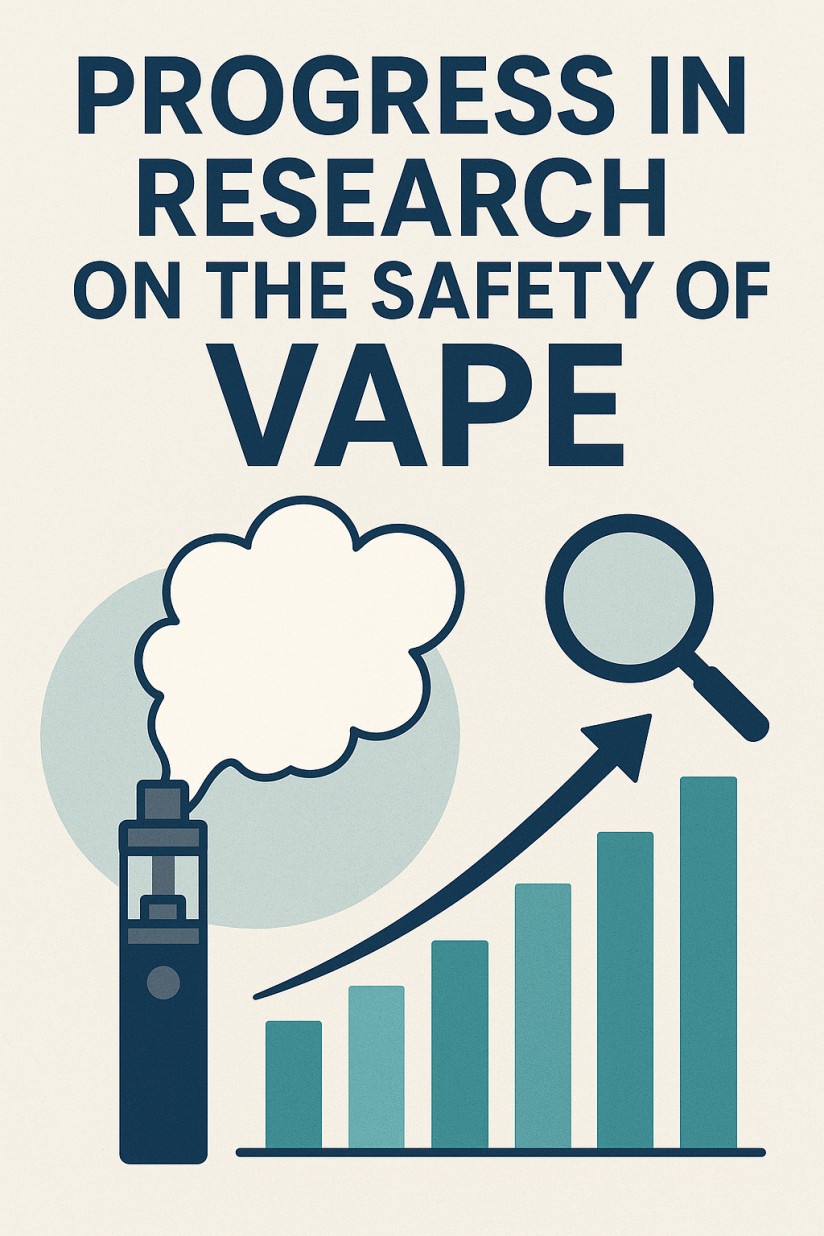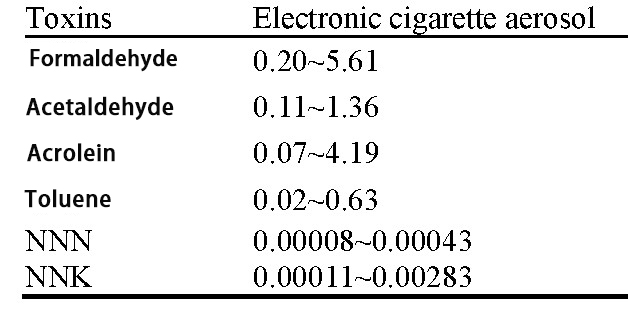
ARE YOU OF LEGAL VAPE AGE?
Please confirm that you are of legal age to purchase vaping products to access our site.

Please confirm that you are of legal age to purchase vaping products to access our site.
Some items are no longer available. Your cart has been updated.
This discount code cannot be used in conjunction with other promotional or discounted offer.
Abstract
Introduction
1. Research on Harmful Substances in VAPE Devices
2. Research on the Safety of VAPE Aerosols
3. Research on the Safety of Flavoring Agents Added to VAPE Liquids
4. Research on the Impact of VAPE on Human Health
5. Impact of VAPE on Smokers' Smoking Behavior
6. Conclusion and Outlook
In recent years, the user base of Vape has gradually increased, drawing widespread attention to their safety. To describe the research outcomes on electronic cigarette safety, this article integrates studies on the influence of certain Vape on smokers' puffing behavior. It reviews recent progress in domestic and international research on electronic cigarette safety from perspectives including electronic cigarette devices, aerosols, flavoring ingredients in e-liquids, and their overall safety to human health. Further research is needed on the transfer patterns of substances from electronic cigarette materials to aerosols, the health impacts of various additives after heating and atomization, and the long-term effects of Vapes on users' puffing behavior.

Vape, also known as electronic nicotine delivery systems (ENDS), are one of the most rapidly developing new tobacco products in recent years. They consist of a battery, a heating atomizer, and a cartridge for storing e-liquid. The e-liquid is atomized into an aerosol through heating for inhalation. Vape originated in China in 2003 and became popular in the United States and Europe by 2006. There is a wide variety of electronic cigarette products, classified by form into cigarette-like simulated types and diverse non-simulated types.
Currently, Vape are considered products for smoking cessation or substitution, but whether they are truly harmless or less harmful than traditional cigarettes remains inconclusive. There are no unified standards or technical regulations for electronic cigarette products across countries, and issues regarding product quality and safety have gradually attracted attention from markets and researchers. As of September 2019, U.S. media reported at least 193 cases in 22 states potentially related to Vape.
The American Medical Association (AMA) and the Centers for Disease Control and Prevention (CDC) urged Americans to stop using any form of Vape until the causes of related deaths are identified. Domestic media in China have also published articles calling for enhanced research on electronic cigarette safety and legal regulation. Therefore, research on electronic cigarette safety issues is urgently needed. As an emerging industry,Vapes evolve rapidly in various aspects. This article summarizes recent studies on the safety of electronic cigarette products to provide a theoretical foundation for formulating regulatory policies and assessing product safety.
Currently, research on the safety of materials in electronic cigarette devices is relatively limited, with societal focus primarily on heavy metal content in device materials and whether these metals migrate with the vapor to affect the human body. Han Shulei et al.used full-scan qualitative and semi-quantitative analysis methods, employing ICP-MS technology, to analyze the main components and materials of metal parts in contact with e-liquid in 15 electronic cigarette samples. In the heating coils, solder joints, and liquid storage chambers, Ni, Cu, and Cr contents were high, with Pb detected in some samples. Fan Meijuan et al.established experimental methods for measuring substance migration from metal parts based on storage and operating conditions of Vapes, analyzing heavy metal migration in 30 market-available products. Results showed a risk of Ni migration to aerosols at 0.02–0.93 μg/200 puffs, and Pb migration risk from metal parts in contact with e-liquid/aerosol at 0.01–1.30 mg/kg. There are no national standards for heavy metal migration in Vape, but Ni and Pb migration levels in many products exceed limits in the national food safety standard GB 4806.9–2016.
Between 2012 and 2015, research on electronic cigarette safety primarily compared the chemical compositions of electronic cigarette aerosols and cigarette smoke. Goniewicz et al.used a modified smoking machine to collect and analyze harmful components in aerosols from 12 electronic cigarette products, as shown in Table 1.
Table 1 Main harmful components in VAPE aerosol

Williams et al.measured elements in electronic cigarette aerosols: Si, 2.24 μg/10 puffs; Al, 0.394 μg/10 puffs; Cu, 0.203 μg/10 puffs; Pb, 0.017 μg/10 puffs; Cr, 0.007 μg/10 puffs; Zn, 0.002 μg/10 puffs. Since 2016, research on aerosol safety has deepened. Fan Meijuan et al. tested 15 electronic cigarette samples using CORESTA-recommended puffing parameters (puff volume 55 mL, 3 s per puff, 3 s interval, square wave curve), measuring glass fibers in aerosols:
(1) All 15 aerosols contained glass fibers with diameters of 7.6–28.3 μm and varying lengths, inferred as artificial glass fibers based on geometry and morphology;
(2) Release amounts were 47–432 μg/200 puffs. Guan Ying et al. evaluated aerosol genotoxicity using a gpt delta transgenic mouse model, finding no significant genotoxicity but notable effects on mRNA expression of DNA damage and inflammation-related genes.
Studies indicate that nicotine is primarily metabolized in the liver to cotinine, which exists in blood and is excreted in urine. Nicotine or nicotine salt release in Vape is significantly influenced by puffing parameters, volume, atomizer ratios, battery power, etc., leading to varying nicotine intake across products or modes. Alasmar studied chronic inhalation of nicotine-containing aerosols in humans and mice, suggesting nicotine-containing Vape can cause addiction. O’Connell et al.conducted a 6-month clinical trial on 15 U.S. adult smokers, finding nicotine salt release lower than in traditional cigarettes but with equally fast blood absorption, good tolerability, and no significant adverse reactions. No studies differentiate nicotine effects via heated atomization from other intake methods. However, many studies show discrepancies between labeled and actual nicotine content in products, raising concerns about overdose. Thus, standardization of nicotine addition is necessary, and further research on impurities in nicotine salts is required.
The safety of flavoring agents in Vape has been a focus. Studies show that 2,3-butanedione or 2,3-pentanedione, when heated and inhaled, can exacerbate respiratory inflammation and cause "popcorn lung". Behar et al.analyzed toxicological evaluations of flavor compounds in 2018, finding 12 compounds (cinnamaldehyde, menthol, benzyl alcohol, vanillin, eugenol, benzaldehyde, p-tolualdehyde, ethyl cinnamate, maltol, ethyl maltol, triacetin, menthone) transfer to aerosols at an average rate of 98%, with over 50% of samples having excessive levels causing cytotoxicity. Recent studies increasingly evaluate flavor safety in Vape. Omaye et al.from the University of California, Riverside, studied JUUL products of different flavors, showing aerosol cytotoxicity highly correlated with nicotine and ethyl maltol concentrations, necessitating assessment of long-term health effects. El-Hage found sucralose in Vape produces two toxic chloropropanols upon heating. Urgent research is needed on traditional flavors under heated atomization, with national standards to control additions in e-liquids.
In recent years, beyond harmful substances, studies have examined electronic cigarette puffing's health impacts. While not definitively quantifying harm, they indicate Vape affect health to some degree.
In 2018, Behar et al.compared cytotoxicity of e-liquids, aerosols, and solvents:
(1) Aerosols produce cytotoxicity in cultured cells;
(2) Stem cells are more sensitive;
(3) Even at low voltage, glycerol-only aerosols cause cytotoxicity.
In 2019, Chen Huan et al.established an evaluation method for e-liquid cytotoxicity, analyzing 16 products in vitro, finding up to 5.47-fold differences unrelated linearly to nicotine, 1,2-propanediol, or glycerol. Raez-Villanueva et al. exposed HTR-8/SVneo cells to flavored or unflavored electronic cigarette vapor-conditioned media with/without nicotine, showing reduced trophoblast invasion and tube formation, warranting pregnancy safety assessments. Chen et al. studied immunological and pathological effects on mice, finding aerosols inhibit cell viability, alter morphology, produce pro-inflammatory cytokines, and impair bacterial/viral defenses, though causes (nicotine, humectants, flavors, etc.) are unclear. Kaur et al.confirmed certain aerosol components may cause respiratory complications via immunological and toxicological experiments, as shown in Table 2.
Table 2 Chemical constituents of e-liquids and electronic aerosol

Johnson et al.from the University of Georgia conducted the first "secondhand electronic cigarette" biomonitoring test on 34 participants over 6 hours in four trials, analyzing urine and saliva for cotinine, trans-3-hydroxycotinine, 3-HPMA, CEMA, and TSNAs before, during, after 4 hours, and next morning. Results showed significant changes in cotinine and acrolein levels but no TSNAs changes. Further research is needed on secondhand electronic cigarette health impacts on non-users.
As Vape gain popularity, they influence users' habits. In 2016, the CDC reported U.S. adolescent electronic cigarette use surpassing traditional cigarettes. Friedman found banning sales significantly increases adolescent traditional cigarette use in a two-year follow-up. Dautzenberg et al.argued Vape are no longer cessation aids for adolescents but novelties or smoking initiators. Rubinstein et al. studied adolescent impacts, finding elevated acrylonitrile, acrolein, propylene oxide, acrylamide, and crotonaldehyde metabolites in 16.4-year-olds on average, recommending warnings on potential dangers and carcinogenicity. Some single-product studies indicate good tolerability without clinical health issues. Flacco et al. in a four-year follow-up found no increased quitting or reduced smoking likelihood. Others link flavors—with or without nicotine—to health declines. Undeniably, Vape audience shifts toward adolescents, influencing their smoking behavior.
Early electronic cigarette safety research yielded unclear, often contradictory results, complicating true impact assessments. Recent findings converge, indicating harmful substances and effects on health and behavior, though measurement variances persist. Comparing similar harmful substances, Vape appear healthier than traditional cigarettes, but unregulated nicotine, salts, and flavors introduce new risks via additions and excesses. While many studies confirm health harms, variances in substance levels and harm degrees necessitate unified standards and further research. Vape popularity undeniably affects adolescent behavior. Future research should clarify material-to-aerosol transfers, analyze heated additive volatiles and impacts, and determine long-term health and behavioral effects. The VAPEPIE believe unified, efficient standards and strict regulations are needed to normalize device materials, nicotine labeling, and flavor additions, while guiding consumer choices rationally.

Comment